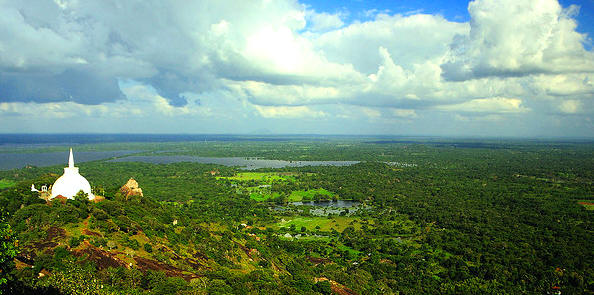It’s very difficult to measure how dense a forest is. A dense forest is a forest thick with trees or having trees growing very closely together.
It has been estimated that about half of the Earth’s mature tropical forests between 7.5 million and 8 million square km of the original 15 million to 16 million square km that until 1947 covered the planet have now been cleared. Some scientists have predicted that unless significant measures are taken on a worldwide basis, by 2030 there will only be ten percent remaining, with another ten percent in a degraded condition.

A Rain Forest
The good news is that there are still some dense forests covering vast area in the planet. Some of them are listed below:
Amazonia basin
Amazonia basin in South America is home to the world’s largest contiguous tropical rain forest. The Amazon is the world’s second longest and the most voluminous river spreading across nine countries. The Amazon basin encompasses 7,000,000 square kilometers (1.2 billion acres), while the forest itself, home to the greatest variety of plants and animals on Earth. occupies some 5,500,000 square kilometers. The majority of the forest is contained within Brazil, with 60% of the rain forest, followed by Peru with 13%, and with minor amounts in Colombia, Venezuela, Ecuador, Bolivia, Guyana, Suriname, and French Guiana. One fifth of all the world’s plants and birds and almost one tenth of all mammal species are found here. Unfortunately, deforestation is a serious threat to the Amazon forests. The mean annual deforestation rate from 2000 to 2005 (22,392 km2 per year) was 18% higher than in the previous five years (19,018 km2 per year). At the current rate, in two decades the Amazon Rain forest will be reduced by 40%.
Congo Basin
The Congo river, second longest river in Africa, generates the second largest contiguous rain forest in the planet along with it’s tributaries. his vast forest runs through six African countries (Cameroon, Central African Republic, Gabon, Congo and Zaire) stretching from the Mountains of the Moon in the eastern Democratic Republic of Congo
to the coast of the Gulf of Guinea. It is a land made famous by the adventures of Stanley and Livingstone and known as a place of brutality and violence for its past. Logging and agricultural clearing are the two major threats to this biologically diverse and rich region and deforestation is happening at an alarming rate. Since the 1980’s, this region the one of the highest loss of forest rates in the world.
Southeast Asia
The Southeast Asian rain forests are the oldest, the most consistent rain forests on the planet. These forests are there since Pleistocene Epoch for more than 70 million years. Southeast Asian forests are one of the Earth’s most biologically diverse forests. These rain forests
stretch from India and Burma in the west to Malaysia and the islands of Java and Borneo in the east. Here again, deforestation of the rain forests in Southern Asia is a serious environmental problem, with over 85% of original rain forests already gone and more being destroyed daily.
Australian temperate forests
Comprising the lowland temperate forests around the Great Dividing Range, the Southeast Australian Temperate Forests comprise a wide variety of vegetation. Unlike the rest of mainland Australia, this region is well-watered with a temperate climate. A diverse mix of vegetation is found throughout this ecoregion, including coastal vegetation,
dense heath, temperate rainforest, riparian communities, wet sclerophyll forests, dry sclerophyll forests, and eucalypt woodlands.The quintessential Australian genus, Eucalyptus dominates in all better-watered regions of Australia, including the Southeast Australia Temperate Forests. There are approximately 700 species of Eucalyptus, and only seven are found outside Australia. Recently this forest has been found to be the home of the world’s most carbon-dense forests, according to researchers from the Australian National University
This ecoregion has been heavily impacted by European settlement, and within the ecoregion the most extensive clearance of native vegetation has occurred to the west of the Dividing Range.
Taiga
The Taiga biome, southerly part of the biome also known as Boreal forest,
stretches across a large portion of Canada, Europe and Asia. It is the largest biome in the world. It has a harsh continental climate with a very large temperature range between seasons. There are two major types of taiga, closed forest, consisting of many closely-spaced trees with mossy ground cover, and lichen woodland, with trees that are farther-spaced
and lichen ground cover; the latter is more common in the northernmost taiga. The taiga is home to a number of large herbivorous mammals and smaller rodents. These animals have adapted to survive a climate harsh for humans. A number of wildlife species threatened or endangered with extinction can be found in the Canadian Boreal forest. Large areas of Siberia’s taiga have been harvested for lumber since the collapse of the Soviet Union. In Canada, less than eight percent of the Boreal forest is protected from development and more than 50% has been allocated to logging companies for cutting.




Recent Comments